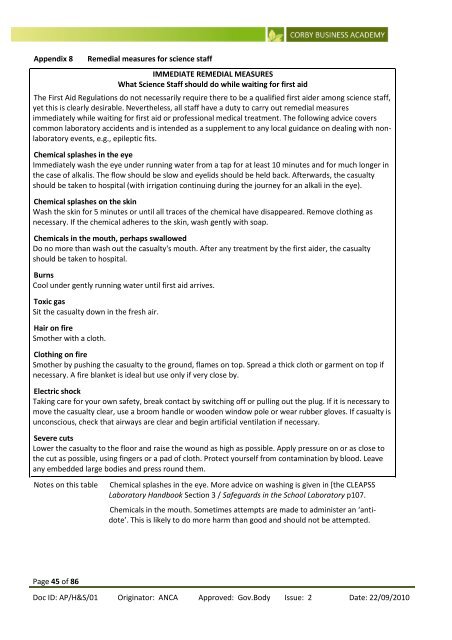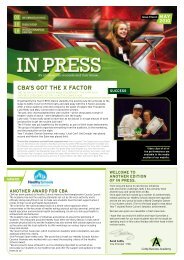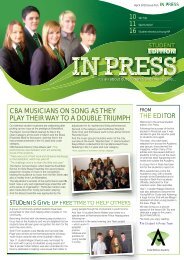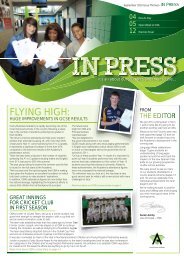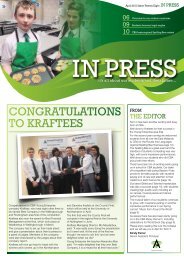H&S/01 Health and Safety - Corby Business Academy
H&S/01 Health and Safety - Corby Business Academy
H&S/01 Health and Safety - Corby Business Academy
- No tags were found...
Create successful ePaper yourself
Turn your PDF publications into a flip-book with our unique Google optimized e-Paper software.
Appendix 8Remedial measures for science staffIMMEDIATE REMEDIAL MEASURESWhat Science Staff should do while waiting for first aidThe First Aid Regulations do not necessarily require there to be a qualified first aider among science staff,yet this is clearly desirable. Nevertheless, all staff have a duty to carry out remedial measuresimmediately while waiting for first aid or professional medical treatment. The following advice coverscommon laboratory accidents <strong>and</strong> is intended as a supplement to any local guidance on dealing with nonlaboratoryevents, e.g., epileptic fits.Chemical splashes in the eyeImmediately wash the eye under running water from a tap for at least 10 minutes <strong>and</strong> for much longer inthe case of alkalis. The flow should be slow <strong>and</strong> eyelids should be held back. Afterwards, the casualtyshould be taken to hospital (with irrigation continuing during the journey for an alkali in the eye).Chemical splashes on the skinWash the skin for 5 minutes or until all traces of the chemical have disappeared. Remove clothing asnecessary. If the chemical adheres to the skin, wash gently with soap.Chemicals in the mouth, perhaps swallowedDo no more than wash out the casualty's mouth. After any treatment by the first aider, the casualtyshould be taken to hospital.BurnsCool under gently running water until first aid arrives.Toxic gasSit the casualty down in the fresh air.Hair on fireSmother with a cloth.Clothing on fireSmother by pushing the casualty to the ground, flames on top. Spread a thick cloth or garment on top ifnecessary. A fire blanket is ideal but use only if very close by.Electric shockTaking care for your own safety, break contact by switching off or pulling out the plug. If it is necessary tomove the casualty clear, use a broom h<strong>and</strong>le or wooden window pole or wear rubber gloves. If casualty isunconscious, check that airways are clear <strong>and</strong> begin artificial ventilation if necessary.Severe cutsLower the casualty to the floor <strong>and</strong> raise the wound as high as possible. Apply pressure on or as close tothe cut as possible, using fingers or a pad of cloth. Protect yourself from contamination by blood. Leaveany embedded large bodies <strong>and</strong> press round them.Notes on this tableChemical splashes in the eye. More advice on washing is given in [the CLEAPSSLaboratory H<strong>and</strong>book Section 3 / Safeguards in the School Laboratory p107.Chemicals in the mouth. Sometimes attempts are made to administer an ‘antidote’.This is likely to do more harm than good <strong>and</strong> should not be attempted.Page 45 of 86Doc ID: AP/H&S/<strong>01</strong> Originator: ANCA Approved: Gov.Body Issue: 2 Date: 22/09/2<strong>01</strong>0


